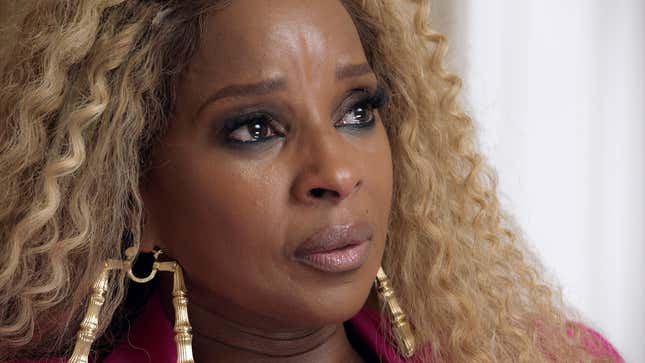Mary J. Blige Is the R&B Queen of Vulnerability, But Her New Documentary Keeps Fans at Arms’ Length
Vanessa Roth's movie for Amazon Studios gives Mary her flowers, but leaves us with only a vague impression of private hell
EntertainmentMovies

Even when pouring her heart out early in her career, Mary J. Blige was working at a remove. On her landmark second album, 1994’s My Life, she sang mostly of pain and sadness, and it was all reified by her perfectly imperfect delivery: the curdle in her voice, her fearlessly heaving runs, her willingness to go flat for the sake of expression. “If you looked in my life, and see what I see,” she sang on the album’s title track. She wasn’t offering a tour, though. She wasn’t telling us what she saw only that she saw it. Her lyrics provided only the most rudimentary indication of what any of this looked like: “Down and out, crying every day, don’t know what to do or to say,” she riffs during one chorus.
Whatever you were thinking, Blige implied, it was worse.
The songs were pure emotion, and the narrative lacunae were readily filled by an audience who had been through it—whatever one’s personal it was—as well. Blige’s cultural position as an avatar of suffering was defined in part by a proprietary attitude toward her biography. Blige was telling her story, but she was also not telling and sometimes pointedly so. She could be detached in interviews, combative, even: During a notorious 1995 exchange with Veronica Webb in Interview Blige implied she was ready to fight the model-turned-journalist. In 2002, The Guardian reported that Blige’s label sent her to etiquette classes for the comments.
Blige clearly remembers what that felt like. In Vanessa Roth’s documentary about the making of Blige’s sophomore album masterpiece, Mary J. Blige’s My Life (premiering Friday on Amazon Prime), Blige watches an interview with herself from the My Life promo cycle. Her 23-year-old (or so) self is unenthused and somewhat impatient with a journalist. “I didn’t want to tell her what I was really dealing with because it was none of her fucking business,” contemporary Blige recalls.
Blige is hardly the only celebrity to share her world, while also making clear that the world she is sharing is what she wants you to see of it. It’s only natural that maintaining boundaries and retaining a sense of control would be important to those living in the public eye. The problem here is not with Blige’s selectively tight lips—she has given us so much that to expect more would be greedy at this point. The problem is there’s no good reason to make a documentary without a commitment to revealing new information. And so Mary J. Blige’s My Life (which Blige co-executive produced and, according to Roth, commissioned), plays like an extended press release; it wishes to remind us why Blige’s work is important, but only superficially.
The film is the equivalent of Blige leaving herself a five-star Yelp review. Certainly, she deserves it, but those who already know that will find little of use here.
Evasiveness may be her documentary’s downfall, but its precedent lives in Blige’s art. On the My Life album, in fact, the lack of lyrical specificity actually functions as an illustrative device and gives the tracks their emotional power.Blige conjures a seemingly endless array of ways to plead for forever within a doomed relationship—songs have titles like “I’m the Only Woman,” “Don’t Go,” and “No One Else.” “I just want to be with you,” Blige sings on one track. “I will never leave you,” on another. Mounting desperation shapes the arc of “I Never Wanna Live Without You,” in which Blige’s narrator can’t sleep or eat and declares, “I don’t wanna be alone,” before being reduced to begging in the outtro: “Baby, won’t you stay with me a little while?” “It’s the little things you do for me/That make me very happy,” she sings in “Be With You.”
By withholding personal details, Blige positions herself in the throes of a lovesickness so deep that she can’t even explain what’s so good about this guy she’s singing about. She’s so in it, so in the moment, that feelings are the only fuel. Even the album’s attempts at lightness occur under ominous clouds: “You know if the time is right/I don’t wanna fuss and fight,” is a hell of a way to introduce a song called “You Bring Me Joy,” but Blige does it. There is no joy without pain here. “Mary Jane,” based on a sample of the Mary Jane Girls’ radio-funk classic “All Night Long,” similarly tempers its joy with wariness: “Ooh baby, not tonight I don’t wanna fuss and fight I just wanna make it right.” The album’s closing track and first single, “Be Happy,” demystifies the turmoil. “How can I love somebody else/If I can’t love myself enough to know/When it’s time/Time to let go?,” Blige cries out.
-

-

-

-

-

-

-

-

-

-

-

-

-

-

-

-

-

-

-

-

-

-

-

-

-

-

-

-

-

-

-

-

-

-

-

-

-

-

-

-








































